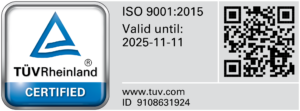Thermal Plasma
The Thermal Plasma process is carried out by generating an ionized flame. Its temperature is between 8,000º and 15,000ºC and it is produced in a gun using an electric arc and special gases. This combination produces thermal plasma, known as the fourth state of matter. The high temperature combined with the high speed at which the material is sprayed guarantees the quality of the coating.
Results
Special hard and high-density coatings, by means of particle-on-particle deposition through mechanical adhesion, microfusion and sintering.
Coatings applied
- Metals: Pure metals and their alloys, including tungsten, molybdenum, titanium, superalloys, stainless steels, nickel-chromium alloys, cobalt-based alloys and others.
- Carbides: Tungsten carbide, chromium carbide in a cobalt or nickel-chromium matrix.
- Intermetallics: Titanium-aluminum, nickel-aluminum, silicon-polyester aluminum.
- Ceramics: Aluminum oxide, titanium dioxide, chromium oxide, stabilized zirconium-yttrium.
Some applications of this process
- Ceramic coatings on kiln rolls, flexographic cylinders
- Wear lining (sleeves and wear rings)
- Thermal barrier coating (gas turbines, turbines and aircraft parts)
- Electrical insulation coating.
Metallization
HVOF – High Velocity Oxygen Fuel
Using the process known as HVOF (High/Velocity/Oxygen/Fuel), the coating is applied using a special gun that withstands high gas pressure. The material particles are projected into an extremely high-speed gas flow (between 1,525 and 1,825m/s).
The particles are injected into the flame, protected from the atmosphere and propelled towards the substrate. The combination of the high gas velocity and the molten powder particles arrive at the substrate exceptionally clean. Interparticle adhesion and the sintering reaction provide a dense, uniform layer.
Results
Coatings with porosity below 1% (high density), used as protection or with the possibility of being machined and ground to the desired dimensions.
Some applications of this process
- Replacing electrolytic hard chrome
- Gloves and wear rings
- Gas compressor rods
- Process pump casing coating
- Steel rolling cylinders
- Flexographic cylinders
Coatings applied
- Nickel and its alloys
- Chrome and its alloys
- Cobalt and its alloys
- Chromium carbides
- Tungsten carbides
Metallization
Electric Arc
This process is carried out by means of a stabilized electric arc between two wires. The material to be sprayed is melted as it passes through the flame generated and atomized onto the substrate using compressed air. The application of these materials protects against corrosion, restores and increases the service life of metallized components.
Results
Dense and economical coatings for various purposes.
Coatings applied
- Carbon steel
- Stainless steel
- Bronze
- Aluminum
- Zinc
- Copper
Some applications of this process
- Coating against atmospheric, urban, marine and industrial corrosion
- Recovery of machine parts
- Hard wear coating
- Protection against corrosion caused by hot gases
Note: In some cases, for better results, the Oxy/Acetylene Flame is used in addition to this process.
Metallization
Oxy/Acetylene flame
Process that uses the combustion flame of gases and compressed air to melt and atomize the particles of the material to be deposited on the previously prepared substrate. This process can easily be applied in the field to large areas that are difficult to access.
Results
Coatings with a repair function or to protect against corrosion.
Coatings applied
- Carbon steel
- Stainless steel
- Bronze
- Aluminum
- Zinc
- Patent metal
- Molybdenum
Some applications of this process
- Corrosion protection coating
- Coating for gas ducts and outlets
- Coating for industrial furnaces and recovery boilers
- Coating for drinking and salt water tanks.


